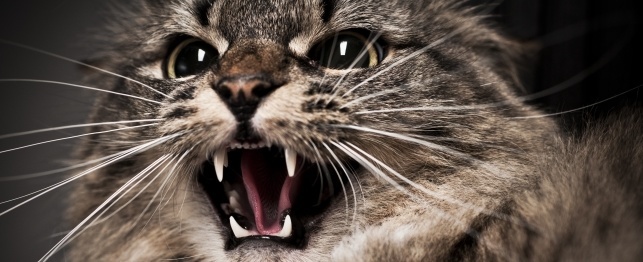by Monique Feyrecilde BA, LVT, VTS (Behavior)
Ugh, we’ve all seen that sight; the fractious cat, crouched in the back of the kennel. He advances and retreats, striking at the cage door. If you touch the latch, he aims for your hands. He may also simply hide in the cage, lashing out if you try to approach.
Cats behaving this way are terribly stressed. Imagine you’re taken to a strange place with no explanation, locked into a tiny room surrounded by strangers, and the strangers periodically grab you and poke you with needles or squeeze your painful injured body parts.
In order to help these cats, we need to be able to safely administer medication to calm them, reduce anxiety, reduce pain, and improve health. Using the safety blanket technique, veterinary professionals can safely remove a fractious cat from a kennel and help it to hold still for a subcutaneous or intramuscular injection of medication.
With practice, this can be done rapidly and skillfully. The animal handler is safe from physical harm. The animal is safe from physical harm. All six directions of movement: Up, down, left, right, forward, and back, are controlled. And…the stress period is as brief as possible.
The Safety Blanket Technique
- Select a large, thick blanket. A double or queen comforter works well.
- If you’re practicing with a decoy animal or friendly cat, a thinner blanket is easier at first.
- Fold the blanket into a square slightly larger than the cage door opening.
- Shield your hand with the blanket to unlatch the cage door.
- Slide the blanket inside the cage door, forming a complete visual barrier.
- PEEK to see where the animal is.
- If the animal is in the center or back of the cage, swing the door open without lowering the blanket.
- PEEK again to verify animal location.
- Rapidly slide the blanket along the ceiling of the cage to the back.
- Rapidly press the blanket to the floor of the cage, securing the animal underneath.
- Use forearms to secure the cat under the blanket, gripping the leading edge in your fists.
- Stabilize the cat, preventing movement or turning.
**An injection can be given at this time through the blanket if desired.
- To remove from the kennel
- Firmly and smoothly slide forearms and fists together, meeting under the cat.
- All portions of the cat should be secured such that it can not turn around or move forward.
- Lift up and move to a treatment location for safe administration of medications.
[embedyt] http://www.youtube.com/watch?v=_Ga5NJkDvq0[/embedyt]
Remember that the key to good emergency animal handling is good preparation. Practice any technique using decoy animals, and friendly animals, prior to attempting to handle a fractious patient. Be sure all members of the handling team have a good plan before starting a handling event, and keep all stressful handling to an absolute minimum. Have injections ready and all staff in place prior to approaching the fractious patient for treatment. Rapid, skillful handling will make veterinary care less stressful and more successful for patient and practitioner alike.
*If any of this information was useful or you would like to see similar content, “LIKE” the Pet ED Veterinary Education and Training Resources Facebook page and subscribe on the HOME page of the PetED website to receive upcoming newsletters and news. If you feel friends or colleagues would benefit from or enjoy this article, feel free to share on YOUR Facebook page.


